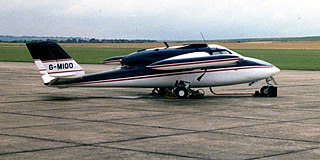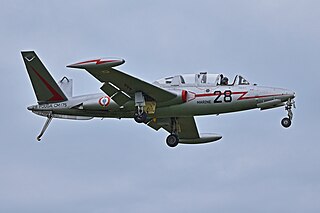See also
Related lists
| CM.88 Gemeaux | |
|---|---|
| General information | |
| Type | Engine test-bed |
| National origin | France |
| Manufacturer | Fouga |
| Number built | 1 |
| History | |
| First flight | 1951 |
| Developed from | Fouga CM.8 |
The Fouga CM.88 Gemeaux was a 1950s French engine test-bed aircraft produced by Fouga. An unusual aircraft, it was two aircraft joined by a common wing.
To meet a requirement to use as an engined testbed for Turbomeca turbojets, Fouga combined two CM.8 fuselages. It used the port and starboard outerwings with a new wing centre section to join the two fuselages. The V-tails fitted to each fuselage were joined at the top in a W configuration. The type was designated the Fouga CM.88-R Gemeaux I and first flew 6 March 1951, it was fitted with two Turbomeca Piméné turbojets, one on top of each fuselage. Further variants were produced as the engine fit was changed.
Data from[ citation needed ]
General characteristics
Performance
Related lists

The Douglas D-558-2 Skyrocket is a rocket and jet-powered research supersonic aircraft built by the Douglas Aircraft Company for the United States Navy. On 20 November 1953, shortly before the 50th anniversary of powered flight, Scott Crossfield piloted the Skyrocket to Mach 2, or more than 1,290 mph (2076 km/h), the first time an aircraft had exceeded twice the speed of sound.

The Convair YB-60 was a prototype heavy bomber built by Convair for the United States Air Force in the early 1950s. It was a purely jet-powered development of Convair's earlier mixed-power B-36 Peacemaker.

The Miles M.77 Sparrowjet was a twin-engined jet-powered racing aircraft built by the British aircraft manufacturer F.G. Miles Limited. It was a one-off conversion, involving the fitting of Turbomeca Palas turbojet engines to the prototype Miles Sparrowhawk, enabling the aircraft to achieve higher performance than could be achieved with its conventional piston engine arrangement.

The Fouga CM.170 Magister is a 1950s French two-seat jet trainer aircraft that was developed and manufactured by French aircraft manufacturer Établissements Fouga & Cie. Easily recognizable by its V-tail, almost 1,000 have been built in France and under licence in West Germany, Israel, and Finland.

The Turbomeca Marboré is a small turbojet engine that was produced by Turbomeca from the 1950s into the 1970s. The most popular uses of this engine were in the Fouga CM.170 Magister and the Morane-Saulnier MS.760 Paris. It was also licensed for production in the United States as the Teledyne CAE J69. In Spain the Turbomeca model Marboré II was manufactured by ENMASA under license with the name Marboré M21.

The Turbomeca Palas is a diminutive centrifugal flow turbojet engine used to power light aircraft. An enlargement of the Turbomeca Piméné, the Palas was designed in 1950 by the French manufacturer Société Turbomeca, and was also produced under licence by Blackburn and General Aircraft in the United Kingdom and Teledyne Continental Motors in the United States as the Continental Model 320.

The Miles M.100 Student was built as a lightweight trainer as a private venture by F.G. and George Miles with development started in 1953. Although not specifically a Miles product, it was promoted as a British Royal Air Force trainer but failed to enter production.

The Fouga CM.10 was an assault glider designed for the French Army shortly after World War II, capable of carrying 35 troops, later converted as a powered transport.

The Hispano HA-200 Saeta is a twin-seat jet advanced trainer designed and produced by Spanish aircraft manufacturer Hispano Aviación. It has the distinction of being the first Spanish aircraft to harness jet propulsion.

The EFW N-20 Aiguillon was Switzerland's first indigenous jet fighter project. The Swiss Federal Aircraft Factory developed a design for a four-engined swept winged fighter following the end of the Second World War. An unpowered sub-scale N-20.01 glider and a turbojet powered test aircraft, also sub-scale and known as the N-20.02 Arbalète ("Crossbow"), were test flown. A fighter prototype N-20.10 Aiguillon was built but never flown, and a twin-engines N.20.20 Harpon was also proposed but not followed up.

The Fouga CM.8 or Castel-Mauboussin CM.8 was a French sailplane of the 1950s, most notable in retrospect due to its place in the development of the Fouga CM.170 Magister jet trainer.

The Fouga Zéphyr was a 1950s French two-seat carrier-capable jet trainer for the French Navy. It was developed from the land-based CM.170 Magister. The Zéphyr was retired in 1994.

The Ikarus 451 is a family of research aircraft designs built in Yugoslavia in the 1950s, all sharing the same basic airframe, but differing in powerplants and cockpit arrangements. One member of the family Ikarus 451M became the first domestically-built jet aircraft to fly in Yugoslavia, on 25 October 1952.
The Turbomeca Astafan is a single-spool, variable-pitch turbofan engine developed from the Turbomeca Astazou. Despite successful flight-testing, an efficient, quiet and clean design and some commercial interest, the Astafan never entered series production. The engines were only flown on the Fouga 90 prototype and Turbomeca's two test aircraft.

The Morane-Saulnier MS.755 Fleuret was a prototype French two-seat jet trainer designed and built by Morane-Saulnier. It failed to gain any orders but was developed into the larger four-seat MS.760 Paris.

The SNCASO SO.9000 Trident is a French jet and rocket powered interceptor aircraft built by aircraft manufacturer SNCASO during the 1950s. As part of a wider effort to re-build French military power during the late 1940s and to furnish France with advanced, new domestically produced designs, a request for a supersonic-capable point-defence interceptor aircraft to equip the French Air Force was issued to SNCASO. In response, the firm designed the mixed-propulsion Trident, powered by a single SEPR rocket engine, which was augmented by wingtip-mounted turbojet engines, and the Air Force ordered two prototypes.
The Dale Weejet 800, or Weejet VT-1 was an early light jet intended for high-speed personal transport or primary military training.
The Procaer Cobra was a two-seat turbojet powered light aircraft designed and built in Italy and flown in the early 1960s. Only one was completed.
The Turbomeca Piméné was a small French turbojet engine produced by Turbomeca in the early 1950s.
The Turbomeca Aspin was a small French turbofan engine produced by Turbomeca in the early 1950s. This geared turbofan design was the first turbofan to fly, powering the Fouga Gemeaux test-bed aircraft on 2 January 1952.